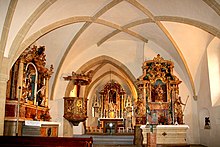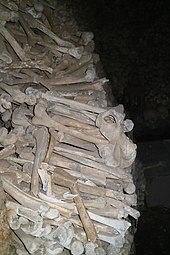Parish Church Deutschfeistritz
The Roman Catholic parish church Deutschfeistritz is located in the market town of Deutschfeistritz in the Graz-Umgebung district in Styria . The church consecrated to St. Martin belongs to the Rein deanery in the Graz-Seckau diocese . Its history goes back to the second half of the 13th century.
location
The parish church is located on the top of the wooded Kirchberg , which rises above the center of Deutschfeistritz.
history
Originally there was a castle that probably belonged to the high libertarians of Feistritz on the Kirchberg. This was demolished in 1151 after the Feistritzers were convicted of high treason. Today's parish church was built in its place in the second half of the 13th century. The church was first mentioned in a document in 1297. In 1301 it became an independent parish. In the years from 1512 to 1515 the nave was widened to the south and provided with a ribbed vault . The church has been incorporated into Rein Abbey since 1607 . Until 1618 there was a pillory inside the churchyard . The current high altar was erected in 1672. At the end of the 17th century, the Erhardi Chapel was built in the south of the church in gratitude for surviving a cattle disease. The Anna Altar was erected in 1780. In 1860 Countess Maria Dietrichstein donated an organ made by Michael Heferer to the church. The interior was restored in 1968.
Architecture and interior design
The church was built in the Gothic style. The Gothic church tower is in the southern part of the choir and has a tent roof . Parts of the tower were designed in the Baroque style. Both the church and the rectory were probably fortified and presumably had fortifications, none of which have survived. A wall surrounds the entire church and the churchyard in the southern part of which there is a cemetery that is no longer used today.
The four-bay nave is spanned by a ribbed vault sitting on semicircular services with a sloping wall template . The windows of the nave have been given a baroque style and have simple bars. The einjochige, increased by three stages, early Gothic designed chorus with five-eighth circuit and underlying vault is supported by a strong ribbed vault spans which was removed in the chorus circuit. The choir also has early Gothic windows. In the three-axis gallery resting on round pillars was built in the late Gothic style and is located in the western part of the nave. Under it is a ribbed vault and the wooden porch probably dates from the 19th century. The southern pointed arch portal of the nave has an eleven-step staircase built in 1747 and a door with a pull ring from the second half of the 17th century. In the west there is a shoulder arch portal . The sacristy has a groin vault and baroque furnishings as well as a door with simple, late Gothic fittings.
The high altar in the Rococo style was probably set up by Johann Baptist Fischer in 1672 and the silver decorations were created by Josef Gäminger in 1778. On the altarpiece , which dates from the second third of the 17th century, St. Martin is depicted in Hungarian national dress. On the right side of the church you can find the Anna altar, made by Jakob Peyer in 1780 . When the women's altar was erected is unknown. In 1715 it received its present form from the Brotherhood of Our Lady . The Baroque Erhardi Chapel from the last quarter of the 17th century is located between the church tower and the south entrance. It has an altarpiece of St. Erhard painted by Josef Reich in 1728 and an artistically designed wrought iron grille.
The octagonal baptismal font of the church dates from 1461 and is made of red marble. The pulpit was probably designed by Johann Jacob Schoy around 1720 and has reliefs depicting the Latin church fathers and the three divine virtues . The basket and the banister of the pulpit are surrounded by a wrought iron grille. The organ dates from 1860 and was made by Michael Heferer. It stands on the gallery and has twelve registers . A handwritten description on the wall next to the baptismal font refers to Countess Maria Dietrichstein, who donated the organ. There is also a statue of St. John Nepomuk from the second quarter of the 18th century and a baroque ovalbid of St. José Calasanz from the second half of the 18th century .
swell
- Federal Monuments Office (ed.): Dehio Steiermark (excluding Graz) . 2nd Edition. Berger, Horn / Vienna 2006, ISBN 3-85028-439-5 , p. 67-68 .
- T. Gartler: The fortified church of St. Martin in Deutschfeistritz, Styria. www.wehrkirche-stmartin.com, accessed on September 18, 2011 (German).
Individual evidence
- ^ A b c d e T. Gartler: The fortified church of St. Martin in Deutschfeistritz, Styria. www.wehrkirche-stmartin.com, accessed on September 18, 2011 (German).
- ↑ a b c d Federal Monuments Office (ed.): Dehio Steiermark (excluding Graz) . 2nd Edition. Berger, Horn / Vienna 2006, ISBN 3-85028-439-5 , p. 67-68 .
Web links
Coordinates: 47 ° 12 '6.2 " N , 15 ° 20' 7.2" E


